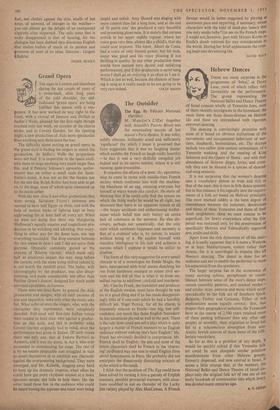Hebrew Dances
The dancing is convincingly primitive with most of it based on obvious stylisations of the movements and occupational behaviour of war- riors, shepherds, husbandmen, etc. The dramas include two rather slow-motion ceremonials, of a Yemenite wedding, and the meeting of King Solomon and the Queen of Sheba : and with their abundance of Hebrew dirges, lyrics, and cross- talk they can be likened to a species of danced- and-sung oratorio.
It is not surprising that the women's dancing uses a vocabulary almost as wide and rich as that of the men; this is rare in folk dance systems, but in this instance it fits logically into the require- ments of a folk art based on Hebraic principles. The most marked oddity is the keen degree of resemblance between the costumes, decorations and music of these Yemenites and those of their Arab neighbours; these we must assume to be superficial, for Jewry everywhere after the Dis- persal was sustained only by the preservation of specifically Hebraic and Talmudically approved arts, crafts and skills.
Apart from the rich dynamism of all the danc- ing, it is easily apparent that it is more a Western, or at least Mediterranean, system rather than Asiatic, for it is centrifugal in impulse like all Western dancing. The dance is done for an audience and not to enable the performer to show his separation from the spectators. The larger surprise lies in the occurrence of many seeming echoes, paraphrases or resem- blances between some of the men's dance steps, certain ensemble patterns, and musical modes— and similar steps, patterns and music which occur sporadically in the folk art of Southern Spain, Bulgaria, Turkey and 'Caucasia. Either of two explanations seems equally correct : first, that despite their geographical isolation, the Yemenites have in the course of 2,500 years retained more of these passing influences' than any other one people; or secondly, their migration to Israel has led to a subconscious absorption from non- Asiatic Jewish sources of these items of the folk- loristic vocabulary. So far as this is a problem of any depth, it would be quickly solved if this Yemenite folk art could be seen alongside similar primitive manifestations from other Hebrew groups, formerly dispersed, and now centred in Israel. It seems a little strange that, at the moment, the National Ballet and Dance Theatre of Israel dis- plays only the original folk art of one out of the many hundreds of communities into which JewrY was divided many centuries ago.
































 Previous page
Previous page